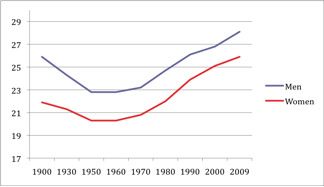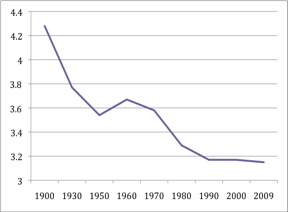 |
June 2011
|
June 2011 // Volume 49 // Number 3 // Commentary // v49-3comm1
Commentaries conform to JOE submission standards and provide an opportunity for Extension professionals to exchange perspectives and ideas.
Ozzie and Harriet Never Were: A Century Review of Family and Consumer Sciences and the Changing American Family
Abstract
As North Carolina FCS celebrates its 100-year centennial, it is time to reflect. For a century, FCS professionals have helped families apply research-based knowledge and principles. This article describes how American families have changed and how we have met those changes in our Extension roles. We also challenge FCS professionals to view the changing trends without bias. Ozzie and Harriet never were a fair representation of family norms, and we must accept the variety of family forms and functions so that our services can be of use to all families, especially those that may not fit the ideal American family.
Introduction
It is not uncommon to hear the words "1950's family" and think nostalgically about the way families were. There is a romanticized idealism that embodies the lovely housewife with the prefect dress and a hard-working Dad who greets his kids at the dining table that is covered by a home-cooked meal. For some, that iconic image represents the ideal American family of times past and present. That image, however, does not fairly represent the American family.
In response to the 100th anniversary of North Carolina's Family and Consumer Sciences program, we submit this review and offer a challenge for FCS professionals to embrace the changing American family. For the past century, Family and Consumer Science agents have had the responsibility of understanding family needs and providing educational programs to meet those needs. Agents historically understood that in order to help families, they needed to understand the complexity of the changing family system.
The family has changed dramatically over the past century—couples marry later (Figure 1), families have become much smaller (Figure 2), divorce has become much more prevalent, and complex family formations now constitute the norm. Today, families rarely look like Ozzie and Harriet—80% of families are complex, meaning there is more than a biological mother and father raising the children (Cancian & Danziger, 2009). There are nuclear families, blended families, same-sex families, single-parent families—and the list goes on. This article explores how Extension FCS professionals have historically responded to changes in family structure and encourages those professionals to continue to understand the changing needs of today's families.
Figure 1.
Average Age at First Marriage

Figure 2.
Number of Children per Family

(Census, 2006)
Changing Family Formations and Demographics
1900-1950
During the first half of the century, women worked very long hours, sun up to past sun down, performing a variety of tasks such as gardening, caring for the house and children, and helping with the crop production (Jones, 2002). Much like the reality of families in today's economy, women's income in the early part of the century contributed to the family welfare. This additional income was often used to provide educational opportunities for the children as well as medical care, shoes and clothes, and educational materials (Jones, 2002).
During this time, the need for education of rural farmwomen became evident. Extension work had been underway for a few decades before the formalization of Extension agents (Comer, Campbell, Edwards, & Hillison, 2006). Just after the turn of the century, studies revealed that farm life was very isolating and that much of the practices of rural farm families were not sanitary or cost-effective. Families were leaving the farms to find work in the cities, prompting the federal government to provided funding for the Home Demonstration Extension Agent through the Smith-Lever Act of 1914. These agents were first assigned to help build communities. Armed with researched-based information, agents worked with farmwomen and their children to teach them how to harvest, market, and sell their goods for a profit (Jones, 2002).
Soon, demonstration clubs were common in most southern counties. They provided education and economic opportunity and were social outlets for women and children. Women viewed these clubs as a saving grace from isolation and poverty because they provided social support and a way to earn a wage. Extension agents worked very long hours in adverse conditions and were the catalysts for needed change. Although the work was hard and the days were long, agents considered themselves missionaries, doing important work to help women and children (Jones, 2002).
1950-1960s
By the time of World War II, women often faced the tasks of working and rearing their children while their husbands were at war. After the war, the U.S. benefited by being one of very few counties whose infrastructure had not been destroyed, allowing manufacturing jobs to skyrocket and the economy to boom. In fact, between 1947 and 1961, national income increased more than 60% (Zinn, 2003). As a result, the federal government was able to afford a great many social programs, including the GI bill. Returning soldiers and their wives hoped to resume normal family life, which resulted in the Baby Boom.
The Baby Boom produced significant changes in society and culture (Zinn, 2003). Many women did leave the workforce at that time, but it is a misconception that the American norm was one breadwinner/household. The media, however, portrayed the family as having one breadwinner—most often, the father. The norm was, and still is, two parents working for income. Even in the 1950's, only 60% of children lived in a "traditional home" where the dad was the sole breadwinner (Mintz, 2001).
In the mid-century, children became the subject of research and program development. For the first time, parenting education practices became available to parents, and adolescents began to remain in the house for longer and longer periods, creating a need for a new developmental stage: the emerging adult. It was during this time that the FCS agents began expanding their focus to meet the changing needs of the families. Up until the mid-century, agents focused on better living conditions for rural women and children, which often included food preservation, home economics, and family financial growth.
In response to the changing family, agents expanded their roles to include family relationships, financial panning, and other family science areas. In fact, the 1955 National Association of Extension Home Economists (NAEHE, 2003) conference theme was "The Home Agent's Changing Role." Those changes continued, and, nearly a decade later, the conference was touting topics such as "Working with Low Income Young Homemakers, Working with Culturally Deprived Low Income Women, and Metropolitan Coordinated Efforts in Consumer Education" (NAEHA, 2003 p. 93). Clearly, the FCS audience was changing from rural farm-families to urban and suburban families, and content specialties were updated to fit the new audience.
1970-1980s
Familial changes continued in America for the next several decades. The 1970's decade was a time of cultural upheaval where divorce, single parent and blended families became the norm. There was new approach to the concept of marriage--partners began to think of marriage and family in terms of individual needs rather than familial needs (Coontz, 2004). The divorce rates doubled in the 1970s and early 80's (U.S. Census Bureau 2006), and families and children struggled financially and emotionally. Children were now alone more than ever before, with both parents at work outside of the home (Figure 3). Once again, the FCS agent's role began to change focus.
Figure 3.
Percentage of Children Living
with Two Parents

Census (2006)
In 1982, the theme of the NAEHE conference was "Families Managing Change: Finding the Balance". The keynote speakers talked about "Future, Change and Families" and "Insecure Present and Uncertain Future" (NAEHA, 2003 p. 93). These topics represented the change from agrarian to urban industrial work environments. Agents were expected to understand and incorporate the struggle between classes, and the importance of helping families meet the emotional needs of children. Also in that conference, there was a push for programming to strengthening family relationships.
1990s-Present
Families today appear strikingly different when compared to an iconic image from 1950s media family—only 7% of families fit the category of working father and stay-home mother (Cancian & Danziger, 2009). Cohabitation continues to increase, and marriages are occurring later in life, if at all. Single parenting is the norm in low-resource communities, and the family structure is much more complex than ever before (Coontz, 2005). New needs arise as family composition changes. Families report a need to balance work and family, and they are also reporting feelings of isolation and fewer connections (McPherson, Smith-Lovin, & Brashears, 2006).
Current family structure has dramatically changed the role of parenting. Middle class parents put a majority of their energy in cultivating their children, which means more time than ever is spent transporting, organizing, and planning children's activities, while working class and poor parents struggle with balancing affordable childcare and neighborhoods safe enough to let their children engage in outside activities (Lareau, 2003). Leisure time for children has nearly disappeared, and the rates of obesity, ADHD, and other risk factors are on the rise.
As before, the role of the Extension agent today is to help families improve their lives, but the method for reaching families has changed. Extension agents today must offer a great variety of programs in a user-friendly manner. Families are busier than ever, so agents are being creative in their approach to education. There is an increase in the use of technology and working with families in partnership with other service-based organizations.
Conclusion
In order to continue to improve the lives of families and remain a viable and imperative community element, Extension staff must continue to grow in their knowledge of the family, expand their acceptance of forms and functions of families, and provide information to families in a way that is relevant and has real impact. We can learn much from our history. Ozzie and Harriet were once an iconic image, but we must expand our thinking about what it means to be a family and how we can better serve all families. Some of the issues that faced families in the past, social isolation and need for connection, are as relevant today as they were a century ago. Agents today have the same compassion and calling to improve the family condition. What has changed however, is the family makeup. With continued growth in these areas, we'll be reflecting in another century of the important work of agents in helping build strong families communities.
References
Cancian, M., & Danziger, S. (2009). Changing poverty, changing policy. New York: Russell Sage Foundation.
Comer, M., Campbell, T., Edwards, K., & Hillison, J. (2006). Cooperative Extension and the 1890 land-grant institution: The real story. Journal of Extension [On-line], 44(3 Article 3FEA4). Available at: http://www.joe.org/joe/2006june/a4.php
Coontz, S. (2004). The world historical transformation of marriage. Journal of Marriage and Family, 66, 974-979.
Jones, L. A. (2002). Mama learned us to work: Farm women in the new south. Chapel Hill: University of North Carolina Press
Lareau, A. (2003). Unequal childhoods: Class, race and family life. Berkley: University of California Press.
Mintz, S. (2001). Does the American family have a history? Family images and realities. OAH Magazine of History. 15, 4. Retrieved from: http://www.oah.org/pubs/magazine/family/mintz.html
National Association of Extension Home Economists (NAEHE). 2003. Historical Archives. Retrieved from: http://www.neafcs.org/content.asp?pageID=13
U.S. Census Bureau (2004). Estimated median age at first marriage, by sex: 1890 to present. Retrieved from: http://www.census.gov/population/socdemo/hh-fam/tabMS-2.pdf
U.S. Census Bureau (2006). Statistical abstract of the United States. Washington, DC. Retrieved from: www.census.gov/prod/2005pubs/06statab/vitstat.pdf
Zinn, H. (2003). A people's history of the United States. New York: Harper Collins Publishers.





